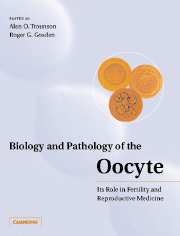Book contents
- Frontmatter
- Contents
- List of contributors
- Preface
- Part I Historical perspective
- Part II Life cycle
- Part III Developmental biology
- Part IV Pathology
- 13 Morphology and pathology of the human oocyte
- 14 The legacy of mitochondrial DNA
- 15 Aneuploidy in ageing oocytes and after toxic insult
- 16 Genetic basis of primary ovarian failure
- Part V Technology and clinical medicine
- Index
16 - Genetic basis of primary ovarian failure
from Part IV - Pathology
Published online by Cambridge University Press: 05 August 2016
- Frontmatter
- Contents
- List of contributors
- Preface
- Part I Historical perspective
- Part II Life cycle
- Part III Developmental biology
- Part IV Pathology
- 13 Morphology and pathology of the human oocyte
- 14 The legacy of mitochondrial DNA
- 15 Aneuploidy in ageing oocytes and after toxic insult
- 16 Genetic basis of primary ovarian failure
- Part V Technology and clinical medicine
- Index
Summary
Introduction
The average age of the menopause - that is, physiological ovarian failure - is 51 years, although conception is very unlikely after the age of 49 (Ginsberg, 1991; McKinlay et al., 1992). Menopausal age is strongly inherited, as shown by a recent study of Australian twins (Snieder et al., 1998), and it is also affected by environmental factors such as smoking (McKinlay, 1996). The distribution of the age of menopause is normal with two standard deviations of the mean being at approximately the ages of 60 and 40 (Torgerson et al., 1997). Menopause before the age of 40 is most commonly taken to be the definition of ‘premature ovarian failure’ and accounts for 1-2% of all women.
The lifespan of the ovary is often thought to be determined by the number of germ cells within it. Early studies focused on counting germ cells in ovaries during fetal and postnatal life. Even though very few ovaries have been subjected to comprehensive germ cell quantification, from the available information it appears that there are at least four phases in the control of germ cell numbers throughout life. During the first 20 weeks of fetal life, there is a rapid multiplication of germ cell numbers, resulting in 3.5 million per ovary (Baker, 1963). In the last 3 months of fetal life, two-thirds of these are destroyed so that each ovary contains 1 million ova. There is then a log-linear decline in germ cells, with only 300 000 left at puberty and 10 000 by the age of 40. This loss of over 900 000 germ cells though apoptosis compares with only 500 or so that might be used up through ovulation during reproductive life (Faddy and Gosden, 1995; Gougeon, 1996). At about the age of 40, an acceleration of oocyte destruction takes place so that few are left at the time of the menopause at 50 (Richardson et al., 1987). The factors which control germ cell numbers are only now beginning to be characterized. For instance, disruption of ovarian apoptosis, in bax knockout mice, can result in a delay of menopausal age (Perez et al., 1999) and mice deficient for sphingomyelin phosphodiesterase 1 had an increased ovarian reserve as evidenced by hyperplasia of preantral, primary and primordial follicles compared with wildtype mice (Morita et al., 2000).
- Type
- Chapter
- Information
- Biology and Pathology of the OocyteIts Role in Fertility and Reproductive Medicine, pp. 258 - 270Publisher: Cambridge University PressPrint publication year: 2003



